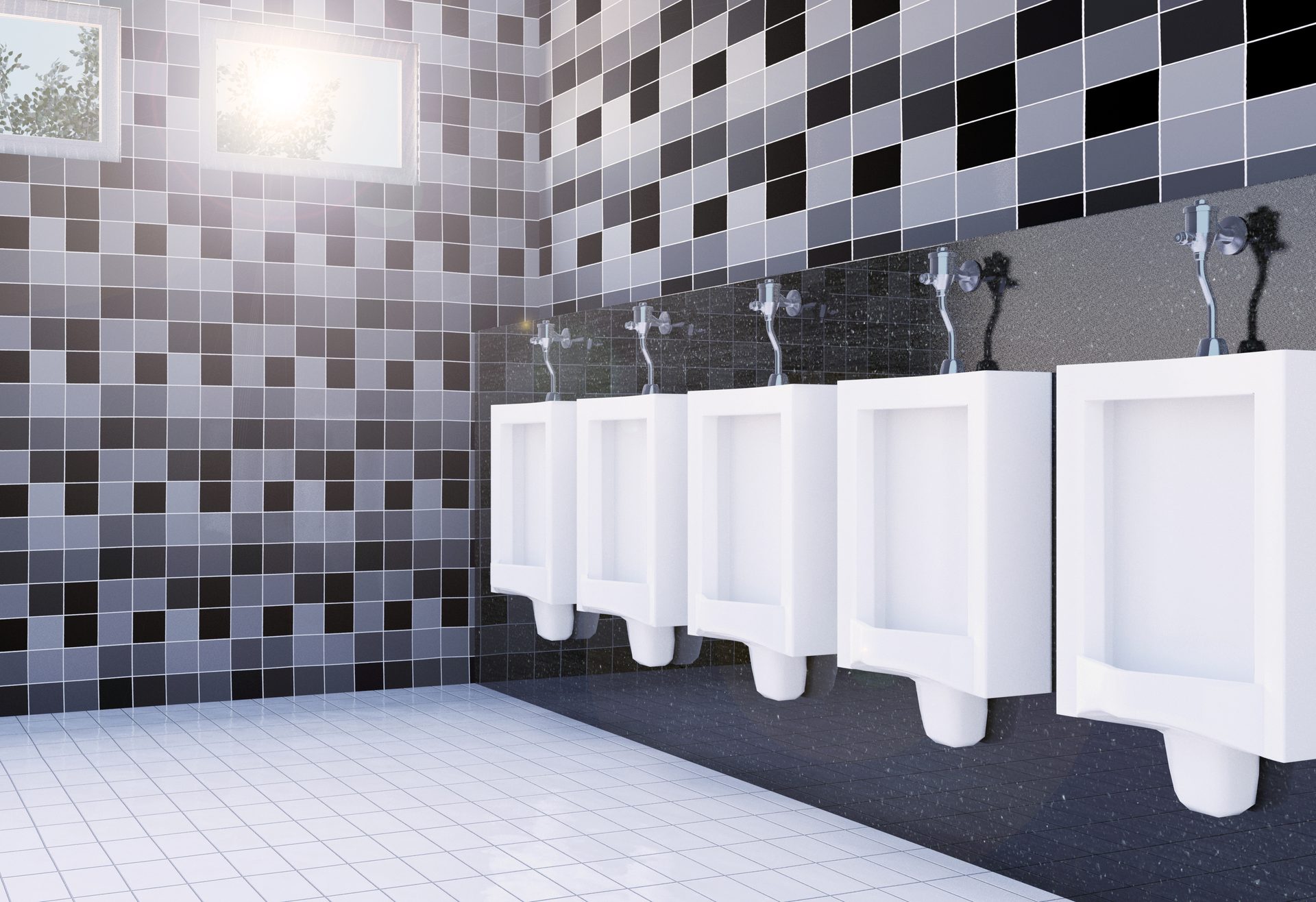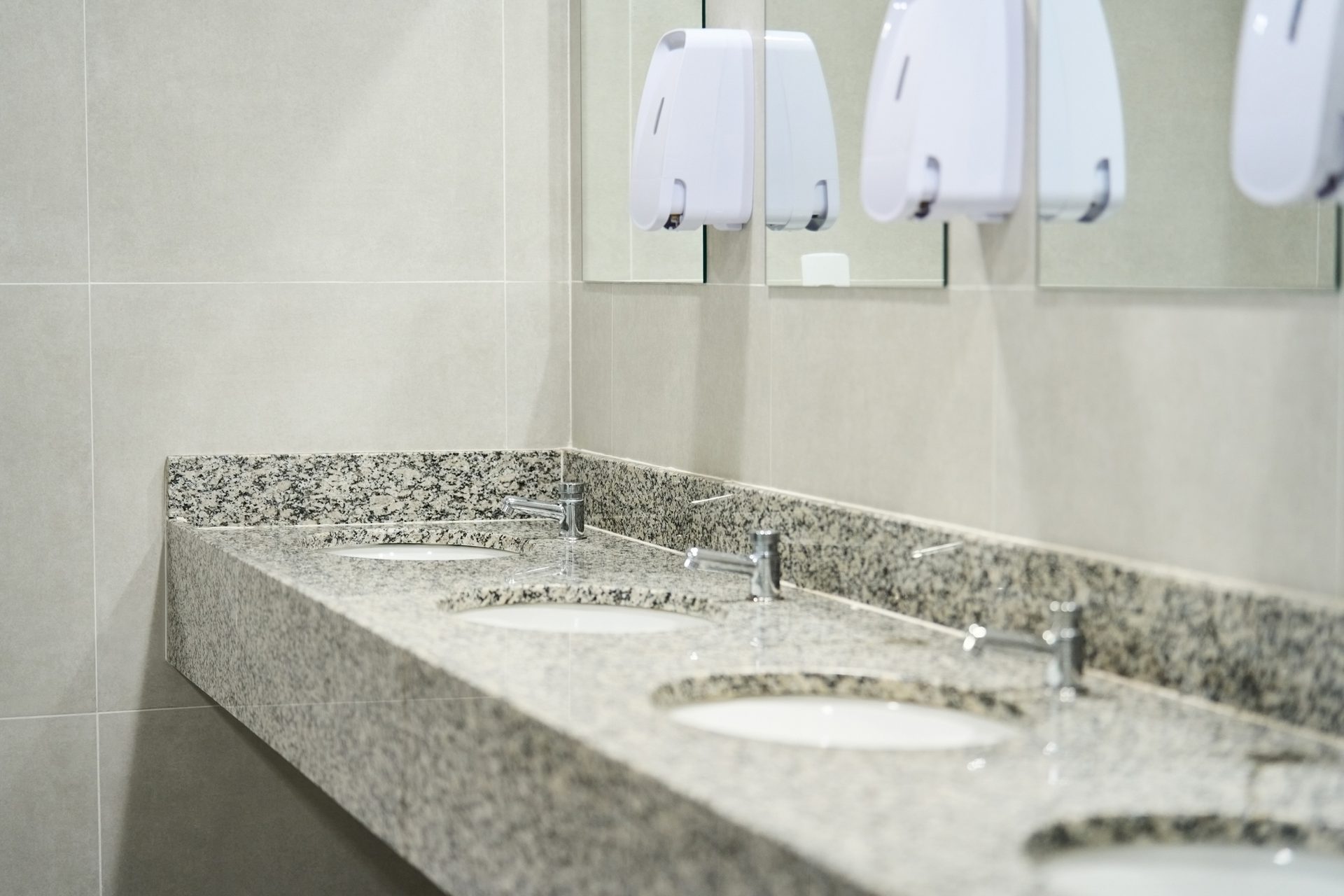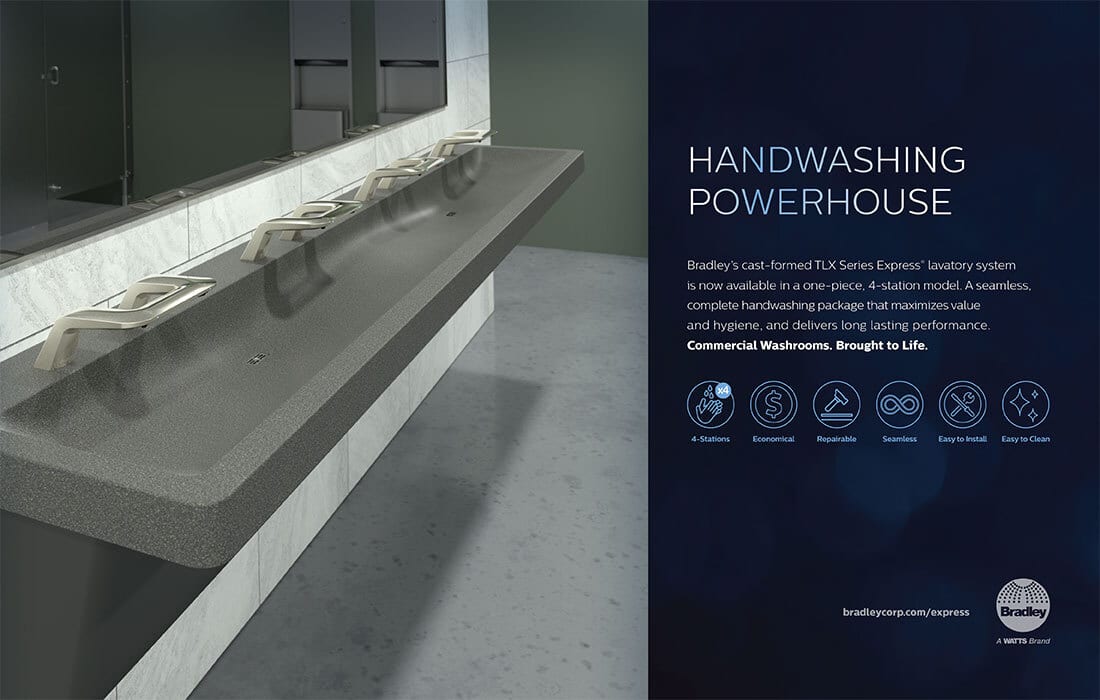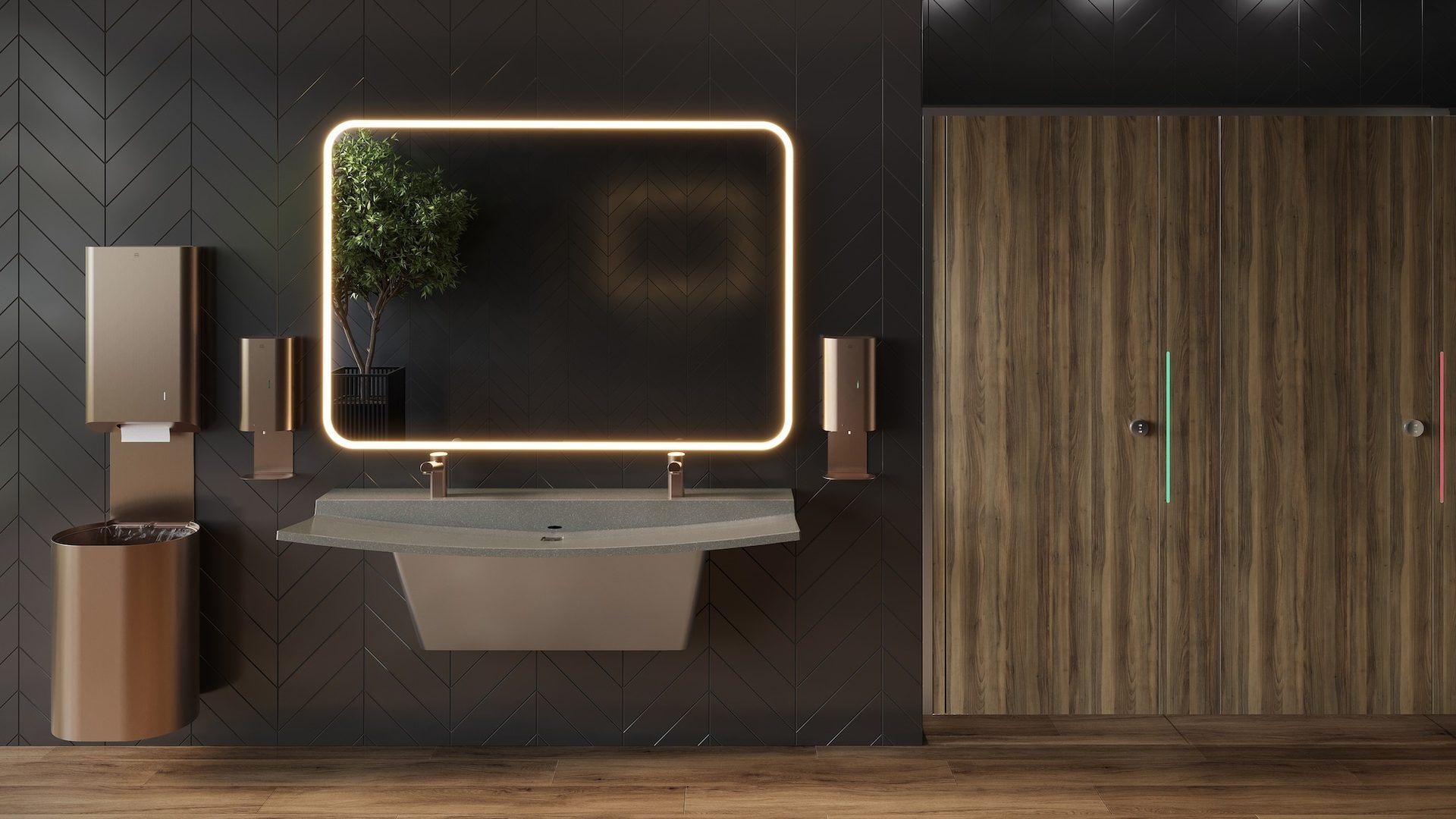Commercial bath and kitchen outlook 2025
Cautious optimism marks 2025 as commercial kitchens and restrooms adapt to labor shortages, smarter technologies and post-pandemic design demands.
By Kristen Bayles

Efficiency, safety, and sustainability guide the latest upgrades in the commercial bath and kitchen sector. Geerati / iStock / Getty Images Plus / Via Getty Images
From senior living facilities to hotels, commercial kitchens and restrooms are getting smarter, greener and more adaptive. But, growth rates and product demand vary widely across sectors. The commercial bath and kitchen sector reflects the broader construction economy: adapting to changing codes, embracing smart technologies and responding to post-pandemic shifts in public health priorities. We spoke with several industry experts to see what we can look forward to – and prepare for – in the commercial bath and kitchen market.
After a year of fluctuating construction starts and shifting material costs, the commercial bath and kitchen market is poised for cautious optimism in 2025. According to Brad Mueller, VP of communications at Charlotte Pipe, “The fundamentals appear to be favorable for growth.” He believes that actions in the White House, like Trump’s new executive order, for example, could act as “jet fuel to the market.” While demand for renovations fuels growth, supply chain concerns and regulatory shifts continue to shape what’s ahead.
The commercial bath and kitchen segment is likely to benefit from reinvestment in interior upgrades, particularly in sectors emphasizing hygiene, accessibility and operational efficiency.
What’s trending: sustainability, smarts and accessibility
Across every sector, sustainability remains a key priority in the commercial bath and kitchen space. “We’re seeing sustainable power options gain traction because people don’t want to change batteries all the time,” says Dan Danowski, Product Manager for Finish Plumbing at Zurn Elkay. “Our goal is to offer fixtures that are hands-free, trouble-free, and optimized for water savings.”
Sensor-activated and touchless products (including soap dispensers, faucets and flush valves) will likely remain popular upgrades in commercial restrooms, according to Gerber Plumbing Fixture’s Vice President of Sales Wholesale, Derek Kirkpatrick. These products represent a broader demand for smarter, more sanitary appliances in commercial bathrooms.
State and local legislation is also raising the bar for water quality in educational and public buildings. Sloan’s Director of Product Development, Morgan Kish, points to Michigan’s new “Filter First” legislation, which mandates that all public schools and childcare centers install bottle fillers with PFOS filters by the end of the 2025–26 school year. “Sloan is working with schools statewide to meet this mandate and protect students from lead exposure.”
In addition to water quality and conservation, smart technology continues to gain traction in commercial restrooms and kitchens. Touchless faucets, automated flush valves, leak detection systems and app-connected fixtures are helping building owners cut waste and improve maintenance efficiency. “Smart and connected restrooms are the future,” says Danowski. “They help save money, reduce downtime, and allow teams to do more with fewer people—especially important given the ongoing labor shortage.”
Accessibility and inclusive design are also influencing commercial bath planning. “There’s a growing push to make entire restrooms ADA-compliant, not just a few elements,” Kish says. “At Sloan, we’re proud to support this shift with a wide range of ADA-compliant products that make facilities welcoming for all users.”
From senior living facilities to hotels, commercial kitchens and restrooms are getting smarter, greener and more adaptive. But, growth rates and product demand vary widely across sectors. The commercial bath and kitchen sector reflects the broader construction economy: adapting to changing codes, embracing smart technologies and responding to post-pandemic shifts in public health priorities. We spoke with several industry experts to see what we can look forward to – and prepare for – in the commercial bath and kitchen market.
After a year of fluctuating construction starts and shifting material costs, the commercial bath and kitchen market is poised for cautious optimism in 2025. According to Brad Mueller, VP of communications at Charlotte Pipe, “The fundamentals appear to be favorable for growth.” He believes that actions in the White House, like Trump’s new executive order, for example, could act as “jet fuel to the market.” While demand for renovations fuels growth, supply chain concerns and regulatory shifts continue to shape what’s ahead.
The commercial bath and kitchen segment is likely to benefit from reinvestment in interior upgrades, particularly in sectors emphasizing hygiene, accessibility and operational efficiency.
What’s trending: sustainability, smarts and accessibility
Across every sector, sustainability remains a key priority in the commercial bath and kitchen space. “We’re seeing sustainable power options gain traction because people don’t want to change batteries all the time,” says Dan Danowski, Product Manager for Finish Plumbing at Zurn Elkay. “Our goal is to offer fixtures that are hands-free, trouble-free, and optimized for water savings.”
Sensor-activated and touchless products (including soap dispensers, faucets and flush valves) will likely remain popular upgrades in commercial restrooms, according to Gerber Plumbing Fixture’s Vice President of Sales Wholesale, Derek Kirkpatrick. These products represent a broader demand for smarter, more sanitary appliances in commercial bathrooms.
State and local legislation is also raising the bar for water quality in educational and public buildings. Sloan’s Director of Product Development, Morgan Kish, points to Michigan’s new “Filter First” legislation, which mandates that all public schools and childcare centers install bottle fillers with PFOS filters by the end of the 2025–26 school year. “Sloan is working with schools statewide to meet this mandate and protect students from lead exposure.”
In addition to water quality and conservation, smart technology continues to gain traction in commercial restrooms and kitchens. Touchless faucets, automated flush valves, leak detection systems and app-connected fixtures are helping building owners cut waste and improve maintenance efficiency. “Smart and connected restrooms are the future,” says Danowski. “They help save money, reduce downtime, and allow teams to do more with fewer people—especially important given the ongoing labor shortage.”
"Facilities managers are increasingly using smart technology to monitor dispenser refills, battery changes, waste disposal, sensored lighting, and occupancy sensors," adds Kris Alderson, Bradley's senior marketing manager. "This data also helps with predictive metrics like maintenance schedules and consumable ordering."
Accessibility and inclusive design are also influencing commercial bath planning. “There’s a growing push to make entire restrooms ADA-compliant, not just a few elements,” Kish says. “At Sloan, we’re proud to support this shift with a wide range of ADA-compliant products that make facilities welcoming for all users.”
Alderson adds that Bradley goes beyond ADA requirements by embracing universal design principles that make restrooms more accessible and easier to use for everyone. “While ADA guidelines focus on key factors like clearance and floor space, our Universal Changing Table addresses a broader need -- providing dignified, functional solutions for individuals with mobility challenges who can't use standard fixtures or infant changing stations," she says.
advertisement
advertisement
According to the American Institute of Architects, commercial construction spending is anticipated to increase by 1.7% this year, and 4.6% in 2026. The commercial bath and kitchen segment is likely to benefit from reinvestment in interior upgrades, particularly in sectors emphasizing hygiene, accessibility and operational efficiency.”


Sensor-activated and touchless products (including soap dispensers, faucets and flush valves) will likely remain popular upgrades in commercial restrooms. AJ_Watt / E+ / Via Getty Image
What sectors are seeing the most growth?
Hospitality remains a bright spot. Mueller notes that post-COVID recovery is driving significant renovation activity. “There’s been a surge in hotel conversions and updates,” he says. In 2024 alone, over 1,300 hotels were in the conversion pipeline, with an additional 660 undergoing major renovations, according to MMCG Invest. This renovation boom is creating strong demand for modern plumbing solutions that deliver long-term performance while meeting today’s design and sustainability standards. Bathroom upgrades, in particular, are a major focus for hoteliers aiming to meet guest expectations around cleanliness, functionality and luxury finishes.
Senior living facilities are also expected to see growth. These facilities must meet stringent accessibility requirements under the Americans with Disabilities Act (ADA), as well as local and state building codes. This includes ADA-compliant restrooms, walk-in showers, grab bars, anti-scald devices and lower sink and fixture heights.
Many facilities were built before current plumbing and water efficiency standards; facility managers are upgrading kitchens and bathrooms to meet new environmental standards, improve water conservation and address deferred maintenance. This includes retrofitting with water-saving fixtures, touchless faucets and safer temperature controls. COVID-19 also highlighted the importance of sanitation and infection control in communal living spaces. As a result, senior living operators are prioritizing touchless fixtures, easy-to-clean surfaces and better ventilation and plumbing systems in bathrooms and kitchens
Conversely, the entertainment sector is expected to slow due to economic uncertainty, according to Jenni Steele, vice president of marketing at Niagara. These types of facilities typically require large-scale restroom infrastructure and high-capacity plumbing systems, but the market is currently stalled by financial caution.
Office buildings also remain relatively quiet. While some urban office properties are upgrading restrooms and kitchens to attract tenants, the overall demand for new construction has decreased significantly due to the ongoing popularity of remote and hybrid work. Plumbing manufacturers are seeing fewer large-scale orders from office developers and instead are supplying small renovation projects or multi-use spaces with flexible layouts.
Challenges: labor and material volatility
Despite the forward momentum, the commercial bath and kitchen market faces familiar headwinds; namely, labor shortages and ongoing material cost volatility. “Consistent, skilled labor is always in demand,” Novak says, noting that retirements, limited training opportunities and shifting workforce priorities have all contributed. Labor shortages and rising material costs will likely cause a push for easier-to-install solutions, according to Gerber’s Derek Kirkpatrick.
Some manufacturers are addressing the issue directly. Sloan, for example, is building a hands-on training facility and developing digital tools that support on-demand education and remote troubleshooting for contractors and building owners alike. Material shortages and price volatility remain persistent concerns, particularly for long-lead projects. “Some jobs are being quoted 6–9 months out—or more,” Novak explains. “That makes budgeting and scheduling tough.” To offset the impact, Oatey is boosting on-hand inventory and working closely with suppliers to reduce fulfillment delays. Gerber is offering tariff-stable product lines sourced from non-affected regions and collaborating with specifiers to offer alternative value-engineered solutions when project budgets are strained.
A market in transition
Though growth is expected to remain in the single digits, the commercial bath and kitchen sector is far from stagnant. Manufacturers and distributors are adapting with a new generation of products that prioritize water savings, compliance, connectivity and inclusive design. With these innovations—and a focus on anticipating future needs—industry leaders are working to ensure that even amid headwinds, the sector continues to deliver performance, value and sustainability for commercial customers.


